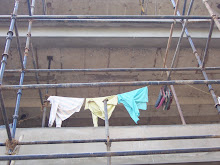“Everything happened too soon”
The map of Bangalore has been drawn and redrawn to envision an identity for an evolving city. Each of these political moves has had a social and cultural impact that unfolded diverse visions that located the city in the trajectory of local, national and global agendas. The city planners and technocrats were etching a social and cultural context to a changing city.
With the coming of public sectors and institutions in the Nehruvian era, the face of the city would change yet again. The vision of Bangalore as a garden city began to be sacrificed for the development of industry.
This city, once envisioned to balance nature and urban development, was soon wrought with basic planning problems. The influx of a work force from around the country and newfound wealth generated a need for housing and other basics of infrastructure. Most long-term plans for the city were compromised, leaving a chequered development, with illegal occupation of reserved land, and filling up of lakes for civic infrastructure. Lack of respect for heritage, nature and culture was rampant, and left the city scarred. The Urban Arts Commission, designed to monitor the aesthetics of the growing city, had little authority. The institution was seen as redundant and was axed to open up the urban landscape to unscrupulous elements who fashioned the city according to the greedy needs of the new elite.
The pressure on civic bodies such as BMP (Bangalore Mahanagara Palike) - now known as BBMP (Bruhat Bangalore Mahanagara Palike) was enormous. The city was bursting at the seams with traffic problems, congestion, water clogging, bad roads and civic amenities. The avenue trees soon fell to road widening, flyovers and the Metro. The planned green avenues and traffic islands gave way to underpasses and magic boxes.
Krumbiegel’s pioneering venture into the globalisation of nature had begun to be pre-empted by the ambitions of another industry that metaphorically flattened the earth. Landscape was replaced by real estate. City aesthetics were sacrificed in the name of development and unprecedented urbanisation. The city’s utopian label of “Garden City” was soon being torn down to accommodate change and to celebrate mindless construction.
Recreating the utopian vision
The opening up of information technology in Bangalore during the 1990s was unmistakably the most significant catalyst in the change in the planning of the city. The vision of Bangalore as another Singapore and the city becoming known as the IT capital and “Silicon Valley of India” was decisive. The unprecedented economic growth of Bangalore has been enviable, and created a global identity that is responsible for Brand Bangalore This accelerated change was welcomed by industry and government. It fashioned new dynamics to the growth and planning of the city, and opened up the cosmopolitan urbanscape to be populated by young software professionals and entrepreneurs.
New promises were made by builders, about the sustenance of nature with gated communities and villas that aped the Bangalore of the past. More corporate gardens created lawns, and golf courses replaced farmland. The corporate horticulturist invested in farmland, and grew hybrid roses and ornamental plants for the world market. Lawns could be ordered by the square feet, and instant gardens transplanted by landscapists overnight. The well-to-do preserved private gardens and the last of the colonial bungalow gardens were retained by nostalgic owners. Nature and culture walks became popular, and serious attempts began to be made to dialogue and debate about urban environment.
The tag of “City Beautiful” was attributed to Bangalore for the systematic cultivation of nature. This involved selection of species, acclimatisation and propagation. The identity of the Garden City was difficult to retain in the process of the emerging metropolis, and the utopian vision had to be constantly recreated by the city to reclaim this loss. Today, in the wave of migration and the fear of loss of native identity by Kannada fans and sons of the soil, the city’s identity has been recast by the profusion of Kempegowda sculptures that dot the city to honour the founding chieftain and reclaim local pride in the language.
The opening up of cyberspace has created new vistas of another technological landscape. This is the new reality for the citizen, looking back in nostalgia for the erstwhile Garden City, and looking ahead with uncertainty and hope, and the pressure and price of living in a changing metropolis. In the midst of urban chaos, the dream has gone sour.
Envisioning a new legacy
Today, we witness protests by citizens who are anguished about the depleting green cover and diminishing green belt. Environmental laws have been bent to accommodate these shifts. We see more flyovers slashing across our skyline to connect people and their destinations. We also see the Metro pushing its way through, and hasty attempts to “paint” the city green. In the din of globalisation, the many voices that resist these changes go unheard.
If we are to save the city beyond this point, we need to our act together, and we need to do it now. We need a comprehensive development plan that will sustain our environment and heritage and take care of further needs without damaging the identity of the city. We need to take lessons from history and from those enlightened planners who were so selfless and passionate about our city.
It is never too late to have a private/public partnership that can re-envision our common future. To have an inclusive agenda, and to take pride in the development of the city. To curb greed. To hold responsible those whose myopic actions taken for short-term goals threaten the city’s long-term well-being. We owe it to the future citizens of Bangalore to inherit an environment that nurtures heritage and nature as a legacy.
Suresh Jayaram





















.jpg)
